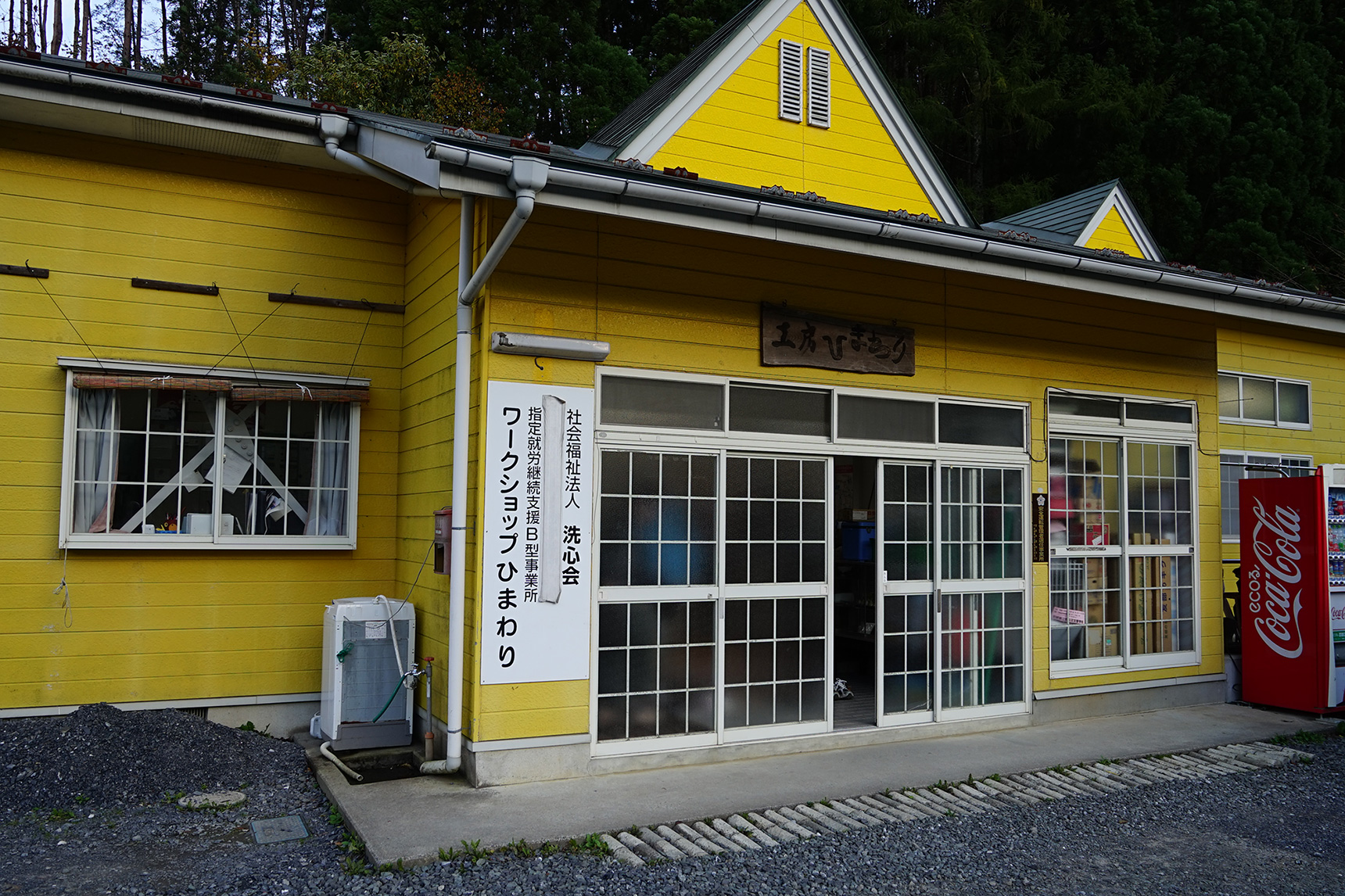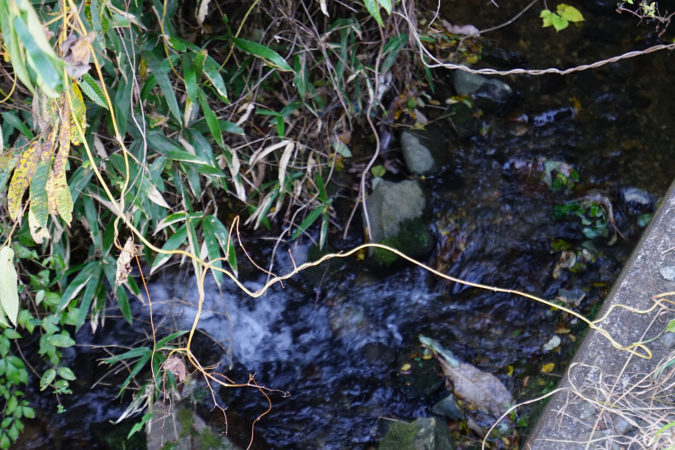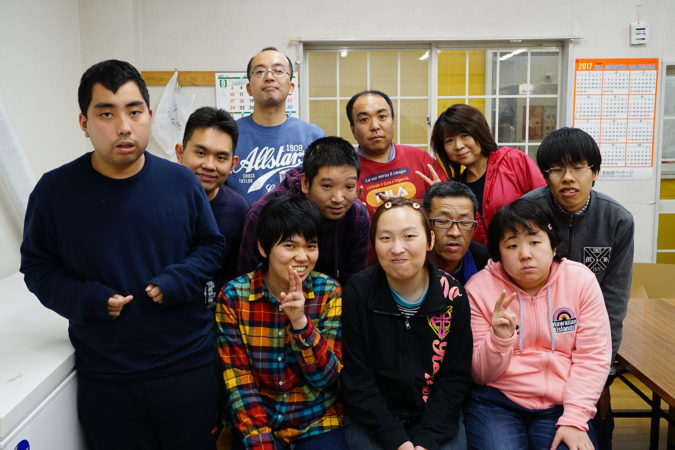 Story: Senshinkai Foundation, Workshop Himawari (Vocational support center for the disabled)
Story: Senshinkai Foundation, Workshop Himawari (Vocational support center for the disabled)Head of support team: Ms. Junko Ito
 Story: Senshinkai Foundation, Workshop Himawari (Vocational support center for the disabled)
Story: Senshinkai Foundation, Workshop Himawari (Vocational support center for the disabled)Could you tell us about the immediate damages caused?
We were to open a new support center called Workshop Fureai (hereafter Fureai) on April 1st in Shishiori district (where fishing boat Kyoutoku Maru was washed ashore). As the district didn’t have a bakery, we decided to try it out. We were ready to open the workshop when the earthquake hit and the tsunami followed. The city of Kesennuma was totally engulfed in fire on that day, and it was said that a site with propane gas cylinders across the street from Fureai was where the fire started. So, this area was in tremendous flames. Even after the fire was put out, we couldn’t come near to the area because of the heat. We could only come to the area where the building was after sometime. Fortunately there was no one killed by the incident among our trainees and the staff, however, some of the trainees lost their family members. There was neither water nor electricity, and our spirit was almost torn down.
Were you at the Workshop Himawari (hereafter Himawari) on the day of the disaster?
Yes.
Who led the evacuation?
Our staff did. Since there were some trainees in Fureai, and because people believed that here at Himawari it was definitely safe (it’s located 29 meters from sea level), staff members brought those people at Fureai to here by our service cars. Most of the staff members were young and they couldn’t imagine clearly how high or how life threatening a tsunami could be even after they heard about the tsunami warnings. Luckily, our chief secretary had experience working on fishing boat and he said that the area was prone to tsunami. With his advice, people decided to take hillside road to come back. The service cars would have been swept by the tsunami if they had taken seaside route, I suppose. It was the good mixture of ages in the staff that saved their lives, I believe. Thanks to that, all the staff and the trainees could safely come back to Himawari.
How was the tremor of the earthquake?
It was with a scale that I had never experienced before. Desks and photocopiers became fast moving weapons. They were not just moving but moving very fast. Trainees started to cry and shout. We instructed people to cover themselves under the tables but they couldn’t move at all. I hadn’t imagined that an earthquake could be that scary. Everything around you could become weapons. Lockers, photocopiers, tables all move so fast. Not just move, they run fast.
How many were you both trainees and staff at Himawari just after the earthquake hit?
We had 12 female trainees here, and male trainees were at Fureai. As for the staff members, the director and I were here at Himawari while other members were at Fureai.
What happened to lifeline services?
They all stopped just after the quake.
How did you manage to obtain information?
We turn the car engine on and listened to the radio. That gave us basic understanding on the damages caused to the area by the disaster. However, since we needed to save gasoline, we didn’t use the cars very often. We didn’t have a radio in our workshop so our access to information was limited.
Did you spend the first night at Himawari?
No, we all took refuge at nearby public facility K-Wave (Kesennuma City General Gymnasium). We took with us cookies we had for sale. There had been a shared understanding that K-Wave was going to be our place if a disaster like that happened because it’s on a hill. There were many people taking refuge when we got there.
Were there any heaters at K-Wave?
No. We didn’t even have blankets there. We were at a part of the same big room as other evacuees at the beginning. However, because of the changes of places and situations, and because they couldn’t meet their family, some of our trainees started acting in hyperactive ways. Every evacuee felt insecure and anxious because of the disaster and their situation. It was difficult for our trainees to keep their rhythm of life in the middle of all other evacuees. They were treated indifferently when they went to bathrooms. Nobody was acting wrong but everybody was feeling overwhelmed by the situation. It was difficult for our trainees to understand and accept the situation. They talked very loudly at bathrooms, and they jumped around even though they were not feeling happy. We explained the situation and asked persons in the facility administration to let us use a separate room. They didn’t understand our necessity. We emphasized that having us there would cause troubles to other evacuees and finally convinced them to spare a meeting room for us. All the staff and the trainees spent in the room eating cookies that night. The situation at the gym didn’t allow us to stay there any longer, and we came back to Himawari the next day.

What did you do about food? I suppose you ran out of cookies soon.
You are right. Food ran out soon. The first person who came with supplies was from Kobe. He saw the situation in Kesennuma in news reports and immediately drove all the way with emergency supplies. He saw Himawari’s signboard and found many people here. He said “You must need some more food, don’t you?” and left a box full of food such as instant noodles. His Kansai dialect sounded very warm. He said there was food at evacuation centers, and he knew there were places near evacuation centers where people were taking refuge without being recognized as official evacuation centers. These places were where people suffered the most in the case of Great Earthquake of Hanshin-Awaji, he recalled. That’s why he was specifically looking for places in that category to deliver supplies. We were so grateful to that person. As people nearby our workshop did not have any emergency supplies, many of them came to Himawari hoping that we had something here. We wanted to give something warm to these people, so we did our best by bringing food from our houses, taking water from the river next to our workshop, boiling the water and made warm things for them. Luckily we had propane gas cylinders here. There were iron plates for baking cookies, so we used them to cook food. We did everything possible to serve the people, so that the trainees who came here would say they would come again.
When did you have your lifeline services back?
We got them back late here. We saw repair trucks for electricity nearby but they didn’t come this way for some time. We were so happy when we could turn the lights on. The water service resumed later but we managed with water from the river next to our workshop. We boiled the water from the river. We wanted to clean the hair and faces of our trainees. Some trainees cried and said “I could finally wash my face” when we cleaned their faces. It was impressive to recognize that something we do everyday without appreciating was actually so precious. Warm water was something we really needed.
Anything particularly difficult?
It was very difficult to obtain medications for trainees because hospitals were also damaged. In that chaotic situation, the director and I took turn and went to hospitals everyday carrying our backpack. Another hard thing was to look for the corps of director’s mother and those of our trainees’ family members. We went opening the blue plastic sheet one by one. The images come back to me every time I see blue plastic sheets. We were so anxious and worried about what would happen as we stood on top of the hill and saw the city of Kesennuma on fire. However, we talked among staff members that we shouldn’t show our tears to the trainees and that we had to keep our smiles. Staff members did their best, including the person who lost her husband in the disaster. We experienced discriminations against and misunderstanding toward persons with disabilities, which was yet another hardship. We tried our best in explaining but people didn’t understand. I think that social welfare works are only possible when you have enough emotional capacity. In that sense, it was understandable that in those chaotic situations people didn’t comprehend about disabilities, and I don’t mean to blame them. Still, it was difficult to experience discriminations and misunderstanding just because some people had disabilities. Once we know that people have these sentiment, it makes us difficult to ask them for help. I felt sorry about that situation. Himawari resumed its operation in less than a month from the day of the earthquake. It was the first of all the support centers in the area, I think. The director had said “If there was even only one trainee who needed Himawari and wanted to come, we had to speed up and open the workshop again soon. We might not have electricity or water, but we will be able to manage with our creativity. Let’s make a space for the trainees to gather.”
I can see that Himawari served as a light of hope for the trainees and their families.
That’s right. Some said they could bear the situation because they could rely on Himawari.

Did you have measures set for earthquakes before the disaster?
We didn’t prepared anything special. Only materials we prepared for disasters were candles and flash lights. We added radio after the disaster. We can’t take out car radios, so we now have portable radios and batteries. We keep lists of contacts such as telephone numbers of our trainees in our service cars now. We also added chargers for mobile phone.
Did people experience changes in how they see things before and after the disaster?
I suppose family members of the trainees experienced changes. People witnessed incidents that took life so quickly. Parents seemed to have started thinking in detail what would happen to their children with disabilities if those kids lost their support. If the children have siblings, these can help them, but not all have siblings. Who will take care of the children then? That’s what parents started wondering. Some opened bank account with their children’s names. Some are trying to obtain special category status for their kids so that they can receive residential care services. Some of these parents send their kids for short stay programs to prepare them for residential care. People started thinking about practical matters on what they can do for the time they leave the children.
Final question. Is there anything you want persons without disabilities to know or things you want to tell them?
We produce bread and cookies at Himawari. These products are tools to facilitate people’s contacts, I believe. The trainees talk to people when they sell our products. With smiles on their faces, they take these products to clients’ residences or offices. People will see that persons with disabilities can also be so cheerful with smiles. I believe that it will be much easier for the trainees to ask for help to someone they have met before when they lost any other support like their family or workshop staff. We are trying to increase the contacts they have with local people. I’d really like to build a base for the trainees with disabilities to be able to keep living here in Kesennuma. Our tools to make this base are these sweet flavored cookies and bread with fresh aroma. These tasty food items help people to get to know each other. I am hoping that the trainees, not only make monetary reward by selling these, but also build their connections to local people for their future. We are now visiting with our products 17 offices such as local companies and local governments. It is more important that people get to know that our trainees are always cheerful and with smiles than they know what Down’s syndrome is or autism is. I am trying to get rid of discriminations against persons with disabilities through these projects. Cookies and bread serve as tools to let people know about the trainees, who are working hard, lighthearted, and with full of smiles. Our trainees can’t live by themselves, but with some supports they can live and shine with smiles. It’s hard to talk to people if you don’t know them. Knowing people makes communicating much easier.
Communication is very important I think. That leads to preparedness for disasters.
I believe that’s the most important thing as preparedness for disasters. Candles and electricity are important, but being able to ask for help and having a secure gathering space are the best ways to keep people safe at disasters.